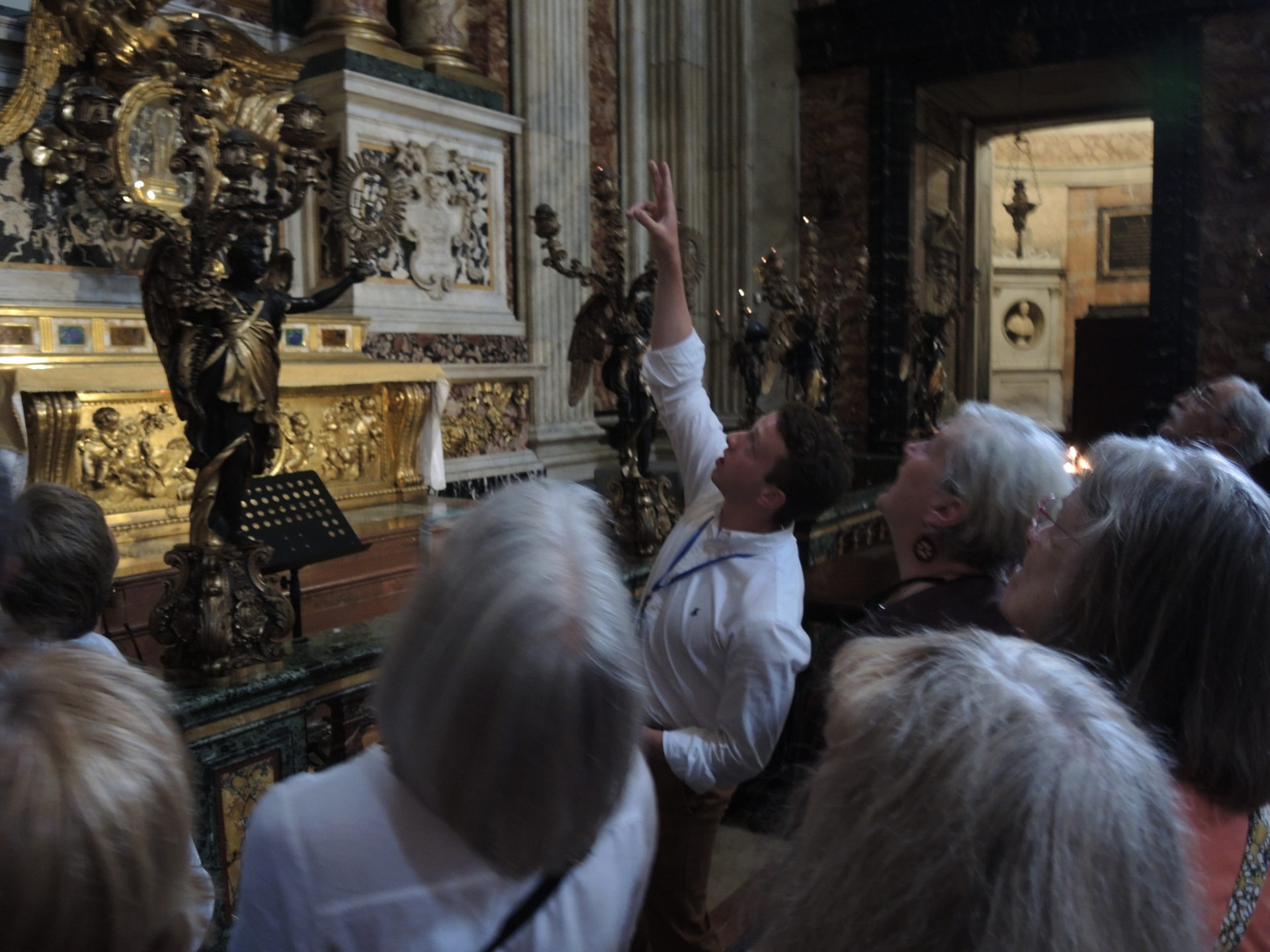LAUREN ROACH
CATHOLIC HERALD STAFF
When Fr. Maher led a group from a Presbyterian College through the St. John of the Florentine Church in Italy, they asked him, “What’s the deal with the foot?” Around them, Catholics swarmed to venerate the golden foot of St. Mary Magdalene enclosed in a glass case.

Students from Marquette University participated in an internship program in Rome, learning about the Church of the Gesu and then giving tours to visitors and pilgrims. (Submitted photo)
That foot is an allegory, Fr. Maher explained. Mary Magdalene’s foot was the first foot in the tomb of the Resurrection and it’s the foot that ran to tell the apostles Jesus rose from the dead. “It’s a representation for the acceptance of faith and the obligation to evangelize,” said Fr. Maher.
Once they understood the gravity of the foot’s preservation and presence, everyone wanted a photo with it, so Fr. Maher emailed those photos to the president of the Presbyterian College and wrote, “Don’t worry, I have them reflecting on a golden foot but not a golden calf.”
This dash of humor is emblematic of Fr. Maher, a Marquette University history professor, in the field and in the classroom. Expertise, levity and an Aristotelian method of provoking self-discovery fill his tours and teaching moments.
Beyond classroom education, Fr. Maher has been touring, working or visiting Rome for the past 30 years. In May, 12 students joined the professor on a new internship program through Marquette University, a program he spearheaded.
The six-week opportunity requires students to learn about the Church of the Gesu — its history, art, layout and significance — and then give tours to visitors and pilgrims.
The encounter and interaction with visual art is somewhat novel for modern Catholics and non-Catholics alike. People no longer have the knowledge of Catholic culture in the visual arts.
“The culture, what it is, not only the truths of the faith but how those truths are articulated in music, art — how theology is expressed in the visual arts — is lost,” said Fr. Maher.
Catholics may see a golden foot and understand it is a relic and therefore significant, but rarely are they given the knowledge to understand, let alone explain, the why.
“Understanding and seeing these works of art is an entrance to the Catholic faith,” Fr. Maher said.
For nearly 18 centuries, the visual culture was the means by which truth was disseminated. Reading was a luxury, and most Catholics were poor and illiterate: “Artistic culture is the culture of the poor,” he explained.
Paintings are not meant to be just pretty. Along with other art forms, paintings are meant to provoke a spiritual response.
“My goal is to transform a church from a museum into an articulation of the faith,” Fr. Maher said.
The internship program he launched fulfills this mission and serves a need at the Gesu in Rome. Two years prior, Fr. Maher submitted a proposal to the Gesu, explaining his idea to employ college students as tour guides in the church.
“No one has more expertise than a college student with five hours of training,” Fr. Maher joked.
The Jesuits “did not really know how this would work, eight college students descending on the Gesu. Well, the Jesuits thought this was the best thing. They just loved it,” he said.
Through the program, students work on their oral presentation skills, public speaking skills and general interactive skills. The faith and the history is more real to them because they must answer questions posed by their tour recipients.
Catechetical in nature, the program also immerses the students in the culture of Rome and Italy. Being familiar with Roman customs, Fr. Maher insists that the best way to learn — how to buy fish at the market or act in an Italian coffee bar — is by experience.
At the beginning of the internship, Fr. Maher brings the students to a piazza and invites them to observe the people that come through the city square and write down how they recognize an American. They shop at the local market and cook their own dinners with local groceries.
Most people associate checkered tables, lasagna and a guy playing an accordion during dinner with Rome. “That’s Disneyland Rome,” Fr. Maher said. “I really get the kids outside of that and to see issues of immigrant Rome, which is a very controversial, interesting dynamic.”
When Fr. Maher suggested buying and then making chicken feet for dinner, after all, Fr. Maher insists, dining on exotic foods is diversity, one student said, “Father, I think we have had enough diversity for the day.”
During the first few days of the program, the students were huddled together walking through the market, and “then by six weeks they are marching through there like they own the place. It’s fun to watch how they gain their confidence,” Fr. Maher said.
“To understand Rome is to understand the European mind. To understand Rome is to understand the world economy and immigration,” Fr. Maher said.
